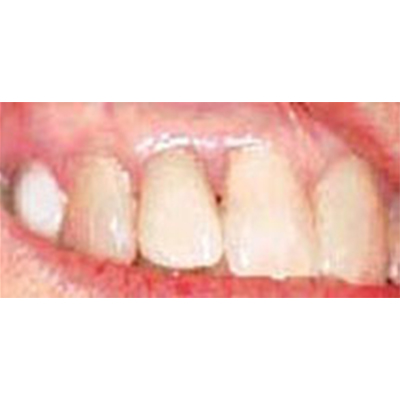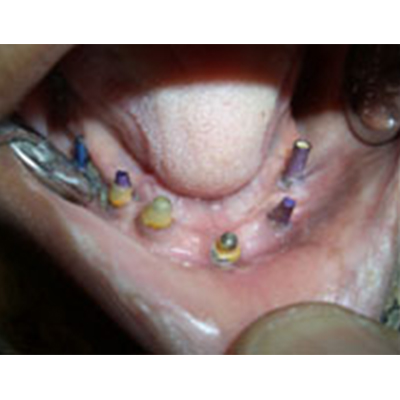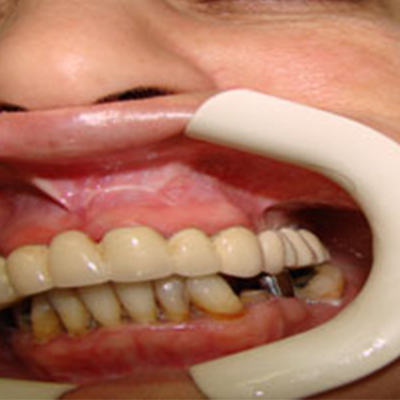Dental Implants
Dental implants are an exciting technology that provides replacement for lost or missing teeth. Unlike bridges, which can sacrifice the vitality of healthy surrounding teeth, and complete or partial dentures, which may be uncomfortable or inconvenient to wear, implants work by mimicking the structure of natural teeth. These small titanium posts are surgically anchored in the jawbone and act as roots for replacement teeth. After they are placed, a period of healing is necessary in which the implants integrate with the bone. Artificial teeth are then constructed and attached to the implants according to each patient’s individual need.
Once completed, dental implants provide the convenience of looking, feeling, and being cared for like natural teeth. Below are some examples of our patients who have benefited from the placement of dental implants.
- Replacement of a single tooth
- Replacement of several teeth
- Replacement of full upper or lower jaw
- Additional procedures
- Bone Grafting
- Sinus lifts

Replacement of a single tooth
If you are missing a single tooth, it can be replaced without having healthy neighboring teeth ground down to support a bridge. Dental implants are a great option for single tooth replacement, especially in the front of the mouth where a good cosmetic result is so important. Here are some examples of patients who have benefited from dental implants.




Replacement of several teeth
If you have lost several teeth, replacing them with dental implants is an excellent alternative to bridges or partials because your replacement teeth are not dependent on support from adjacent teeth and do not require the inconvenience of a removable appliance. Below are some examples of patients who chose dental implants to restore multiple missing teeth.
Replacement of full upper or lower jaw
If you have lost all of the teeth in one of your jaws, a full denture may work for the short term. However, without tooth roots, the jawbone slowly shrinks, causing the denture to use its snug fit. This may lead to discomfort and can even change the shape of your face. Dental implants, fused to the jawbone, keep the bone healthy and your teeth securely in place. Once implants have been placed in an arch, crowns can be restored individually or with fixed bridgework or overdentures.
Individual crowns or a fixed bridge are permanently secured to the implants, while removable overdentures are held in place by a bar and clip. Below are some examples of different types of restorations for patients who were missing all of their upper or lower teeth


Additional procedures
Prior to implant surgery, it is important to be evaluated by an oral surgeon. A full mouth x-ray, or a panorex, will be taken and an exam performed to determine the amount of bone available and the position of the sinuses and the inferior alveolar nerve, which gives feeling to the lower lip and chin. There are often situations in which additional procedures are necessary to prepare a patient for implant surgery. The most common of these procedures include bone grafting, sinus lifts, and nerve repositioning.


Bone Grafting
Over a period of time, the jawbone associates with missing teeth atrophies or is reabsorbed. This often leaves a condition in which there is poor quality of bone suitable for the placement of dental implants. However, we now have the ability to add or grow bone where needed. In most cases, synthetic or demineralized bone is placed in a socket after a tooth is extracted or at the time of implant placement. These materials speed up the integration process and allow new bone to grow around the implant. Patients who have been missing teeth for many years may require a more extensive surgery in which bone is taken from their chin or hip and grafted to their jaw. After approximately six months of healing, the jawbone is then ready for the placement of implants. Bone grafting technology not only gives us the opportunity to place implants of proper length and width, it also gives us a chance to restore functionality and esthetic appearance.
Sinus lifts
Upon evaluation of their panorex, some patients are found to have low sinuses that may interfere with the placement of dental implants. Fortunately, a procedure can be performed that elevates the sinus membrane and places bone grafting material onto the sinus floor. Implants can then be successfully placed in the back part of the upper jaw.



